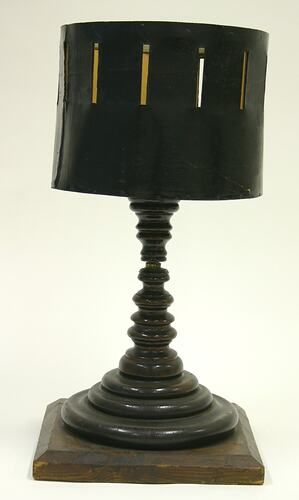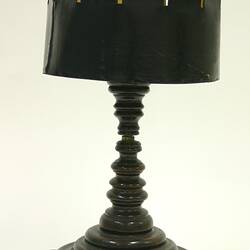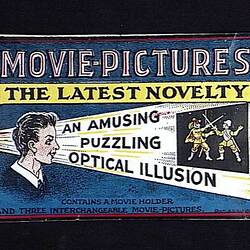Summary
The zoetrope was part of a range of popular philosophical or optical toys created in the 19th century. Like the zoetrope, most attempted to create the illusion of movement using a series of static images. These images were printed onto long paper strips which were interchangeable, allowing different scenes to be viewed using the zoetrope.
Zoetrope comprises a cylindrical shade, painted black on the exterior, with individual slits spaced around the circumference to form viewing slits. Beneath the slits, on the inner surface of the cylinder, is a paper strip which features 13 colour ink drawings of a moustached man wearing a red shirt with a blue collar and blue trousers. He has black hair. Each image shows him in a different position. These strips were produced in sets and were interchangeable. A brass holder in the centre would have been fitted with a lighted candle for illumination. The base of the cylinder is covered in an optical patterned paper of black, white, red, yellow and green. The cylinder is mounted on a turned wooden pedestal, with a brass spinning mechanism in the centre, and square base that are covered in a dark brown varnish. As the cylinder spins, the user looks through the slits at the pictures on the opposite side of the cylinder's interior. The scanning of the slits keeps the pictures from simply blurring together, so that the user sees a rapid succession of images producing the illusion of motion, the equivalent of a motion picture.
This zoetrope is part of the Francis Collection of pre-cinematic apparatus and ephemera, acquired by the Australian and Victorian Governments in 1975. David Francis was the curator of the National Film and Sound Archive of the British Film Institute as well as being a co-founder of the Museum of the Moving Image in London, which was operational between 1988 and 1999.
Physical Description
Zoetrope composed of a cylinder and stand. The exterior of the cylinder is black and lacquered. Thirteen viewing slots perforate the upper half of the cylinder at regular intervals. The interior of the cylinder has a strip of paper pasted onto its wall underneath the slots. This paper features 13 sequential images of a man whose head falls off, then reattaches itself. The images are produced in black, blue and red ink. The base of the cylinder is covered with a geometric patterned paper of black, red, yellow, green and white. The centre of the base has a brass coloured candle holder, with candle in situ. The zoetrope stand is of turned wood, fixed to a square base plate. A brass mechanism in the upper part of the stand allows the cylinder to spin.
More Information
-
Collection Names
-
Collecting Areas
-
Acquisition Information
Loan & Subsequent Donation from Australian Film Institute (AFI), Mr David Francis, by Nov 1990
-
Inventor
William Horner, England, Great Britain, 1834
Of Zoetrope -
Collector
Mr David Francis, London, Middlesex, England, Great Britain, 1990
-
Classification
-
Category
-
Discipline
-
Type of item
-
Object Measurements
550 mm (Length), 295 mm (Width), 290 mm (Height)
-
Maximum dimensions
278 mm (Width), 549 mm (Height)
Measurement From Conservation.
-
Dimensions
355 mm (Height), 850 mm (Circumference), 276 mm (Outside Diameter)
Measurement From Conservation.
-
Keywords
Animation, Optical Illusion Devices, Pre-Cinema Moving Images, Zoetropes





